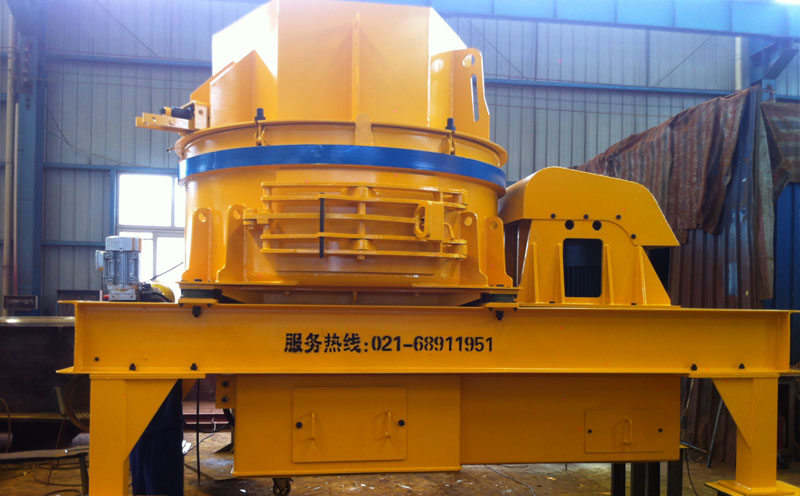Vertical Shaft Impact Crusher - Introduction
What is a Vertical Shaft Impact Crusher?
A Vertical Shaft Impact Crusher (also known as VSI crusher or sand making machine) is an efficient crushing equipment that uses "impact" as the core crushing principle. It is mainly used for medium-fine crushing and shaping sand making of materials, with the core being throwing and impacting materials through a high-speed rotating impeller to achieve crushing.

1. Core Working Principle
- After materials enter the equipment through the feed port, they are divided into two crushing paths: one part directly falls into the high-speed rotating impeller and is thrown out at high speed after acceleration; the other part enters the crushing cavity from the outside of the impeller.
- The materials thrown at high speed collide violently with the materials and cavity walls in the crushing cavity, generating friction and grinding, and finally achieving the crushing and shaping effect.
- The crushed materials are classified through the screening system: those that meet the particle size requirements are discharged, and the unqualified ones re-enter the crushing cavity for secondary processing.
2. Main Characteristics
- High crushing efficiency, especially suitable for medium and low hardness materials (such as limestone, quartz stone, construction waste, etc.). The finished product has good particle shape (high cube content), making it suitable for sand making needs.
- Compact structure, small floor area, easy installation and maintenance. Some models can be equipped with a mobile chassis to achieve flexible operation.
- Wear parts are made of high wear-resistant materials, with long service life and strong operational stability, suitable for continuous high-intensity production.
3. Applicable Fields
- Sand and Gravel Building Materials Industry: Used for sand making processing of raw materials such as river pebbles and granite, producing finished sand that meets construction standards.
- Construction Waste Treatment: Crushing and shaping concrete blocks, waste bricks, etc., to prepare recycled aggregates or recycled sand.
- Mine Mining: Performing medium-fine crushing of ores to provide qualified materials for subsequent mineral processing or deep processing.
- Chemical and Metallurgical Industry: Processing industrial solid wastes such as gangue and slag to realize resource reuse.
Difference Between Cone Crusher and Vertical Shaft Impact Crusher
The core differences between cone crushers and vertical shaft impact crushers lie in their crushing principles, applicable scenarios, and finished product effects. The former focuses on coarse/medium crushing of medium-hard materials, while the latter specializes in medium-fine crushing/sand making and shaping. Specific differences can be clearly distinguished through the following dimensions:
1. Differences in Core Crushing Principles
- Cone Crusher: Adopts a composite crushing method of "extrusion + bending + grinding". It realizes crushing by applying extrusion force to materials through the narrowed gap between the moving cone and the fixed cone, belonging to the static pressure crushing mode.
- Vertical Shaft Impact Crusher: Takes "impact + collision" as the core. After the high-speed rotating impeller throws out materials, they collide violently with the cavity wall or other materials, belonging to the kinetic energy crushing mode.
2. Comparison of Key Performance and Applicable Scenarios
| Comparison Dimension | Cone Crusher | Vertical Shaft Impact Crusher |
|---|---|---|
| Adaptable Material Hardness | Mainly high hardness (e.g., basalt, granite, iron ore), compressive strength ≤ 350MPa | Medium and low hardness (e.g., limestone, river pebbles, construction waste), compressive strength ≤ 250MPa |
| Main Crushing Stages | Coarse crushing, medium crushing (some models can be used for fine crushing) | Medium-fine crushing, sand making, material shaping |
| Finished Product Particle Shape | Mostly acicular and flaky, low cube content, poor particle shape | High cube content, round and uniform particle shape, good shaping effect |
| Capacity Range | Large single-machine capacity (up to over 1,000 tons per hour), suitable for large-scale continuous production | Medium to high capacity (tens to hundreds of tons per hour), slightly lower capacity than cone crusher in sand making scenarios |
| Energy Consumption and Wear | High energy consumption, relatively uniform wear of wear parts (lining plates), long replacement cycle | Medium energy consumption, fast wear of impellers and impact plates, especially when processing high-hardness materials |
3. Differences in Core Application Scenarios
- Cone Crusher: Focuses on scenarios such as large-scale mine mining and metal ore crushing. For example, the medium crushing link in granite mines or the crushing processing of iron ore before mineral processing. It is suitable for demands that have low requirements on the particle shape of finished products and focus on efficient crushing of high-hardness materials.
- Vertical Shaft Impact Crusher: Corely used in scenarios such as sand making in sand and gravel plants, shaping of recycled aggregates from construction waste, and processing of high-quality aggregates for expressways. For example, crushing pebbles into finished sand for construction, or further shaping materials produced by cone crushers to improve particle shape quality.
 English
English
 简体中文
简体中文
 عربي
عربي
 Русский
Русский
 Français
Français
 Español
Español
Get In Touch With Us